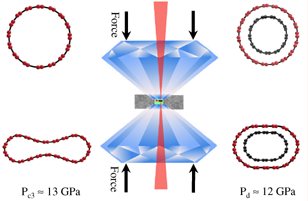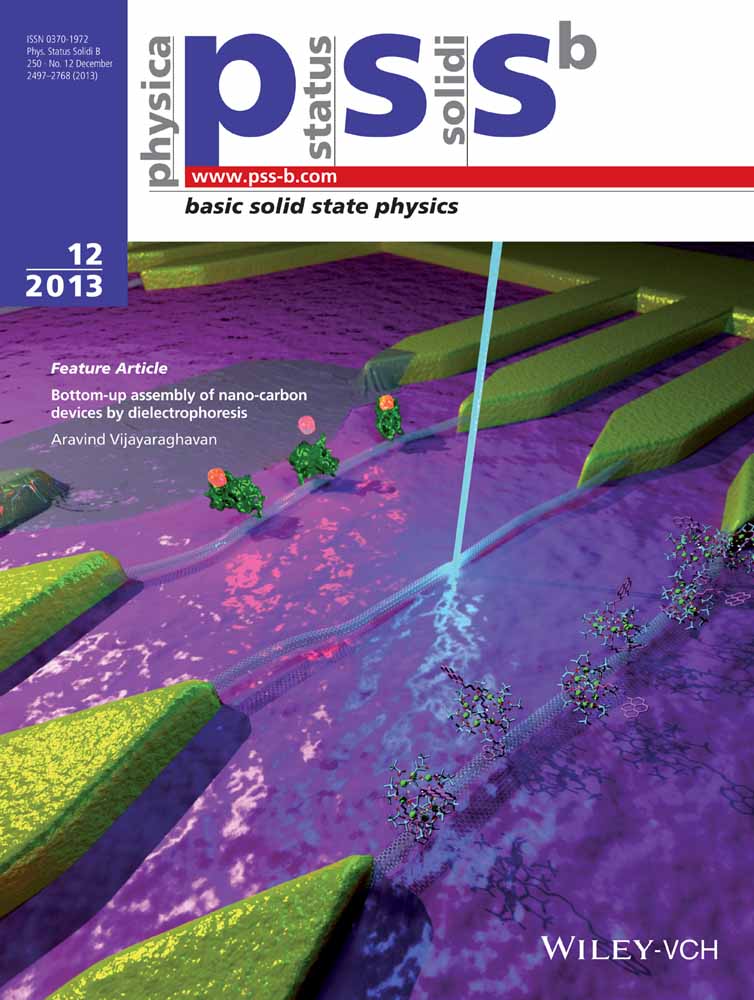Role of the pressure transmitting medium on the pressure effects in DWCNTs
B. Anis
Experimentalphysik 2, Universität Augsburg, 86159 Augsburg, Germany
Search for more papers by this authorF. Börrnert
IFW Dresden, P. O. Box 270116, 01171 Dresden, Germany
Search for more papers by this authorM. H. Rümmeli
IFW Dresden, P. O. Box 270116, 01171 Dresden, Germany
Search for more papers by this authorCorresponding Author
C. A. Kuntscher
Experimentalphysik 2, Universität Augsburg, 86159 Augsburg, Germany
Corresponding author: e-mail [email protected], Phone: +49 (0)821 598 3315, Fax: +49 (0)821 598 3411Search for more papers by this authorB. Anis
Experimentalphysik 2, Universität Augsburg, 86159 Augsburg, Germany
Search for more papers by this authorF. Börrnert
IFW Dresden, P. O. Box 270116, 01171 Dresden, Germany
Search for more papers by this authorM. H. Rümmeli
IFW Dresden, P. O. Box 270116, 01171 Dresden, Germany
Search for more papers by this authorCorresponding Author
C. A. Kuntscher
Experimentalphysik 2, Universität Augsburg, 86159 Augsburg, Germany
Corresponding author: e-mail [email protected], Phone: +49 (0)821 598 3315, Fax: +49 (0)821 598 3411Search for more papers by this authorAbstract
We present a high-pressure optical spectroscopy study on double-walled carbon nanotubes with  0.80 nm and
0.80 nm and  1.45 nm using nitrogen, argon, and alcohol-mixture as pressure transmitting medium (PTM). The pressure-induced redshift of the optical transitions in the outer tubes is very small below 10 GPa, demonstrating the enhanced mechanical stability due to the inner tube. An anomaly at the critical pressure
1.45 nm using nitrogen, argon, and alcohol-mixture as pressure transmitting medium (PTM). The pressure-induced redshift of the optical transitions in the outer tubes is very small below 10 GPa, demonstrating the enhanced mechanical stability due to the inner tube. An anomaly at the critical pressure 
 12 GPa signals the onset of the pressure-induced deformation of the tubular cross-sections. Using argon as PTM affects the results quantitatively: The
12 GPa signals the onset of the pressure-induced deformation of the tubular cross-sections. Using argon as PTM affects the results quantitatively: The  value is lower and the absorption bands are broadened considerably. Furthermore, alcohol-mixture as PTM seems to destroy the tubes completely above 10 GPa due to its solidification. The results are compared with those for single-walled carbon nanotubes.
value is lower and the absorption bands are broadened considerably. Furthermore, alcohol-mixture as PTM seems to destroy the tubes completely above 10 GPa due to its solidification. The results are compared with those for single-walled carbon nanotubes.

References
- 1 A. Jorio, R. Saito, G. Dresselhaus, and M. S. Dresselhaus, Raman Spectroscopy in Graphene Related Systems (Wiley-VCH Verlag GmbH, Weinheim, 2011).
- 2 A. Krishnan, E. Dujardin, T. W. Ebbesen, P. N. Yianilos, and M. M. J. Treacy, Phys. Rev. B 58, 14013 (1998).
- 3 E. Hernández, C. Goze, P. Bernier, and A. Rubio, Phys. Rev. Lett. 80, 4502 (1998).
- 4 J. P. Lu, Phys. Rev. Lett. 79, 1297 (1997).
- 5 S. Kawasaki, Y. Matsuoka, T. Yokomae, Y. Nojima, F. Okino, H. Touhara, and H. Kataura, Carbon 43, 37 (2005).
- 6 S. Lebedkin, K. Arnold, O. Kiowski, F. Hennrich, and M. M. Kappes, Phys. Rev. B 73, 094109 (2006).
- 7 M. Yao, Z. Wang, B. Liu, Y. Zou, S. Yu, W. Lin, Y. Hou, S. Pan, M. Jin, B. Zou, T. Cui, G. Zou, and B. Sundqvist, Phys. Rev. B 78, 205411 (2008).
- 8 C. Caillier, D. Machon, A. San-Miguel, R. Arenal, G. Montagnac, H. Cardon, M. Kalbac, M. Zukalova, and L. Kavan, Phys. Rev. B 77, 125418 (2008).
- 9 B. Anis, K. Haubner, F. Börrnert, L. Dunsch, M. H. Rümmeli, and C. A. Kuntscher, Phys. Rev. B 86, 155454 (2012).
- 10 A. L. Aguiar, E. B. Barros, R. B. Capaz, A. G. Souza Filho, P. T. C. Freire, J. M. Filho, D. Machon, C. Caillier, Y. A. Kim, H. Muramatsu, M. Endo, and A. San-Miguel, J. Phys. Chem. C 115, 5378 (2011).
- 11 A. L. Aguiar, A. San-Miguel, E. B. Barros, M. Kalbá\ifmmode \check c\else č, D. Machon, Y. A. Kim, H. Muramatsu, M. Endo, and A. G. Souza Filho, Phys. Rev. B 86, 195410 (2012).
- 12 R. Pfeiffer, H. Kuzmany, C. Kramberger, C. Schaman, T. Pichler, H. Kataura, Y. Achiba, J. Kürti, and V. Zólyomi, Phys. Rev. Lett. 90, 225501 (2003).
- 13 P. Puech, H. Hubel, D. J. Dunstan, R. R. Bacsa, C. Laurent, and W. S. Bacsa, Phys. Rev. Lett. 93, 095506 (2004).
- 14 L. Alvarez, J. L. Bantignies, R. Le Parc, R. Aznar, J. L. Sauvajol, A. Merlen, D. Machon, and A. San Miguel, Phys. Rev. B 82, 205403 (2010).
- 15 A. Sohi and R. Naghdabadi, Acta Mater. 55, 5483 (2007).
- 16 K. Thirunavukkuarasu, F. Hennrich, K. Kamarás, and C. A. Kuntscher, Phys. Rev. B 81, 045424 (2010).
- 17 C. A. Kuntscher, A. Abouelsayed, K. Thirunavukkuarasu, and F. Hennrich, Phys. Status Solidi B 247, 2789 (2010).
- 18 A. Abouelsayed, K. Thirunavukkuarasu, F. Hennrich, and C. A. Kuntscher, J. Phys. Chem. C 114, 4424 (2010).
- 19 B. W. Smith, R. M. Russo, S. B. Chikkannanavar, F. Stercel, and D. E. Luzzi, Mater. Res. Soc. Symp. Proc. 706, Z3.13.1 (2002).
- 20 Z. Wu, Z. Chen, X. Du, J. M. Logan, J. Sippel, M. Nikolou, K. Kamaras, J. R. Reynolds, D. B. Tanner, A. F. Hebard, and A. G. Rinzler, Science 305, 1273 (2004).
- 21 B. Anis, M. Fischer, M. Schreck, K. Haubner, L. Dunsch, and C. A. Kuntscher, Phys. Status Solidi B 249, 2345 (2012).
- 22 G. Huber, K. Syassen, and W. B. Holzapfel, Phys. Rev. B 15, 5123 (1977).
- 23 J. C. Charlier, P. Lambin, and T. W. Ebbesen, Phys. Rev. B 54, R8377 (1996).
- 24 G. Liu, X. Wang, J. Chen, and H. Lu, Phys. Status Solidi B 245, 689 (2008).
- 25 R. B. Capaz, C. D. Spataru, P. Tangney, M. L. Cohen, and S. G. Louie, Phys. Status Solidi B 241, 3352 (2004).
- 26 S. P. Chan, W. L. Yim, X. G. Gong, and Z. F. Liu, Phys. Rev. B 68, 075404 (2003).
- 27 M. H. F. Sluiter and Y. Kawazoe, Phys. Rev. B 69, 224111 (2004).
- 28 J. A. Elliott, J. K. W. Sandler, A. H. Windle, R. J. Young, and M. S. P. Shaffer, Phys. Rev. Lett. 92, 095501 (2004).
- 29 M. Hasegawa and K. Nishidate, Phys. Rev. B 74, 115401 (2006).
- 30 U. D. Venkateswaran, A. M. Rao, E. Richter, M. Menon, A. Rinzler, R. E. Smalley, and P. C. Eklund, Phys. Rev. B 59, 10928 (1999).
- 31 M. J. Peters, L. E. McNeil, J. P. Lu, and D. Kahn, Phys. Rev. B 61, 5939 (2000).
- 32 J. Sandler, M. S. P. Shaffer, A. H. Windle, M. P. Halsall, M. A. Montes-Morán, C. A. Cooper, and R. J. Young, Phys. Rev. B 67, 035417 (2003).
- 33 V. Gadagkar, P. K. Maiti, Y. Lansac, A. Jagota, and A. K. Sood, Phys. Rev. B 73, 085402 (2006).
- 34 S. Klotz, J. C. Chervin, P. Munsch, and G. L. Marchand, J. Phys. D, Appl. Phys. 42, 075413 (2009).
- 35 S. You, M. Mases, I. Dobryden, A. A. Green, M. C. Hersam, and A. V. Soldatov, High Press. Res. 31, 186 (2011).
- 36 X. Yang, G. Wu, and J. Dong, Appl. Phys. Lett. 89, 113101 (2006).
- 37 A. Merlen, N. Bendiab, P. Toulemonde, A. Aouizerat, A. San Miguel, J. L. Sauvajol, G. Montagnac, H. Cardon, and P. Petit, Phys. Rev. B 72, 035409 (2005).




